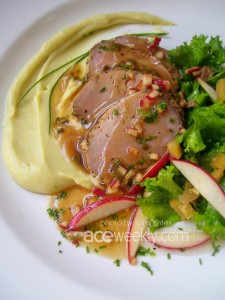Chef Tom’s Food and Cooking Column appears on page 13 of the Ace Weekly print edition. Text and Photos by Chef Tom.
I stood at the Saturday Farmers Market staring at an interesting stack of Paw Paw Plantation rhubarb.
Have you ever made rhubarb sauce?
I suppose I could have lied, said yes, and moved on.
“No, I haven’t.”
“Here’s what you need to do. Don’t peel them. Just cut off the brown spots and cut them up as big or little as you like. Put them into a pan and add a little water. Not too much water or you’ll dilute the flavor of the rhubarb. Don’t leave the stove. Bring the water to a boil and turn it down to a simmer. Don’t leave the stove or it might scorch.”


As I asked him a few questions, he genuinely seemed to care that I wanted to cook his rhubarb. His sauce. His old fashioned recipe for rhubarb sauce.
Smitten by his culinary storytelling, I temporarily lost my mind and asked him one last really stupid question.
“What color will the sauce be after it’s cooked?”
Really? Did I actually think cooked green rhubarb would magically morph into the wonderfully pretty pink color of an old fashioned rhubarb pie?
Mr. MacIntosh weighed my rhubarb, bagged it up, and flashed me a wicked sweet smile.
“It’ll turn out the color that it is.”
Enough said.
I was surprised that he didn’t pat me on my head and gently shoo me away.
I followed his method, but changed it up at the end by pulling the rhubarb from the heat when the water evaporated to prevent it from breaking down completely. I wanted individual tart bites of rhubarb for wilted mustard greens.
Meat.
Succulent pork tenderloin. To make it a little easier to handle, I sliced a 1 1/2 pound pork tenderloin in half and browned the halves in a hot skillet on all sides, about 2 minutes per side. After brushing both pieces with dijon mustard, I rolled them through cracked tellicherry peppercorns, snipped chives, and finely grated fresh horseradish root. I thoroughly packed the coating onto the tenderloins and placed them in an oiled baking dish before sliding them into a 350 degree oven to roast for 35 minutes.
To make the most of the pork bits left into the bottom of the skillet, I cranked the skillet over a medium flame and added 1 cup fresh apple cider and 1/2 cup chicken stock. I brought the sauce to a boil, reduced the heat to a simmer, and let the sauce reduce to 1/3 cup (almost a glaze), before pulling it off the heat and swirling 2 tablespoons of unsalted butter into the sauce for a glossy finish.
Potatoes.
I have a thing for white sweet potatoes. They’re tricksters. They may look like normal white thin-skinned potatoes, but they taste like sweeter fluffier versions of their pale orange sweet potato counterparts.
White Sweet Potato puree.
I peeled 1 1/2 pounds of Casey County white sweet potatoes, sliced them into uniform pieces, and dropped them into a stockpot of cold water. I brought the water to a boil, salted it generously, turned the heat down to a simmer, and let them rip for about 30 minutes, until fork tender. After draining the potatoes, I pureed them in a blender with a few pats of butter, salt, pepper, and a splash of warmed whole milk. I kept the puree warm in a mixing bowl placed over simmering water while I pulled everything together.
Greens.
To balance the richness of the pork, apple cider gravy, and potato puree, I took a somewhat twisted approach with gorgeous Scott County mustard greens.
Wilted Mustard Greens Salad.
I tore the feathery tender mustard green leaves into bite sized pieces and tossed them into a a bowl with thinly sliced Fuji apples. After heating a small cast iron skillet over medium heat, I sauteed 8 ounces of diced Finchville country ham until it crisped and rendered about 2 tablespoons of salty ham fat. I scooped the caramelized ham from the skillet to drain before adding 1/4 cup minced shallots to the smoking fat. When the shallots softened, I deglazed the skillet with 1/3 cup red wine vinegar, 2 tablespoons of dark brown sugar, and 1 tablespoon dijon mustard. Yep. Warm country ham vinaigrette.
I pulled the pork tenderloin from the oven, tented it, and let it rest for 10 minutes .
After slicing the pork into medallions, I nestled the medallions over the white sweet potato puree and napped them with the reduced apple cider gravy before finishing with fresh chives and diced apples. I spooned the wilted mustard greens to the side of the pork with a scattering of tart diced rhubarb, country ham, and thinly sliced apples.


Surprisingly, the delicate mustard greens wilted ever so slightly from the warm country ham vinaigrette. Their tender bitter leaves popped with tart rhubarb and crisp wet apples, providing a soft acidic balance to the sleepy meat and potatoes.
Meat. Potatoes. Greens.
Fresh horseradish-crusted pork tenderloin with apple cider gravy, white sweet potato puree, and wilted mustard greens.
Southern comfort food.










